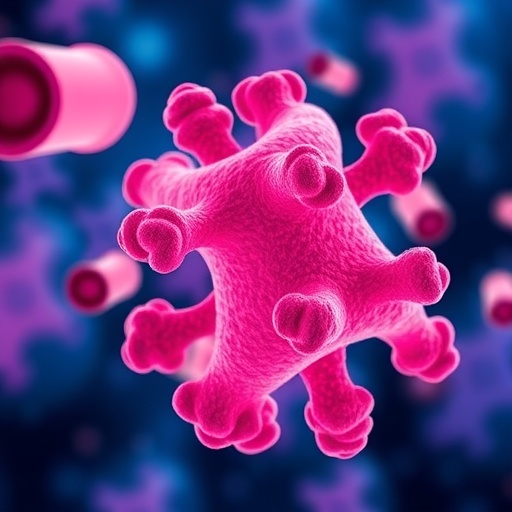In the ever-evolving landscape of drug discovery, the focus on small molecule inhibitors has significantly shifted toward understanding their biological interactions at a molecular level. A prime example of this is the recent research led by Zhu, Qiu, and Xu, which sheds light on an innovative virtual screening strategy aimed at identifying covalent inhibitors targeting Janus kinase 3 (JAK3). This study is particularly relevant considering the role of JAK3 in various immune disorders and cancers, rendering it a focal point for therapeutic intervention.
The research introduces a cutting-edge approach that synergizes multi-conformational consensus calculations with covalent docking methods, presenting a comprehensive framework for virtual screening. The core idea is to enhance the accuracy of predicting ligand-binding modes and affinities by taking into account multiple conformational states of the target protein. This contrasts significantly with traditional virtual screening methods that often rely on static protein representations. By adopting a more dynamic perspective, the researchers aim to capture the complex and transient nature of protein-ligand interactions that are critical for successful inhibitor design.
Covalent inhibitors have emerged as a promising class of drugs due to their ability to form stable bonds with target proteins, thus ensuring prolonged efficacy. However, designing these inhibitors presents unique challenges, primarily due to the specificity required to avoid unintended interactions with off-target proteins. The proposed strategy by Zhu and colleagues addresses this by incorporating a multi-conformational approach, which enhances the predictive power of covalent docking. This method allows researchers to evaluate not just single-point interactions but also the global landscape of conformational dynamics.
The study outlines a systematic protocol where the protein’s conformational ensemble is generated through molecular dynamics simulations. This ensemble reflects the diverse structural forms that JAK3 can adopt, facilitating a more rational design of covalent ligands. This comprehensive analysis accounts for various critical factors such as ligand-binding energy, molecular flexibility, and potential steric clashes. As such, this approach stands to dramatically improve the likelihood of identifying potent JAK3 inhibitors.
Additionally, the research emphasizes the importance of consensus scoring in virtual screening. By integrating results from multiple docking poses and conformations, the proposed method increases the reliability of binding affinity predictions. The consensus calculation serves as a means to filter out false positives, elevating the chances of identifying true covalent inhibitors. This methodological rigor sets a new standard in the field of computational drug design and highlights the need for sophisticated approaches in studying complex biological systems.
The implications of this research are profound, especially in the context of treating conditions linked to JAK3, such as autoimmune diseases, where aberrant cytokine signaling is prevalent. The ability to rapidly screen through vast libraries of compounds, identifying potential covalent inhibitors with better specificity, means accelerated drug discovery timelines and the potential for more targeted therapies. Moreover, this advancement could lead to significant breakthroughs in developing therapies that are less prone to side effects, enhancing patient outcomes.
Furthermore, the integration of advanced computational techniques with traditional biological assays illustrates a shift towards a more holistic understanding of pharmacological interactions. By bridging these two realms, researchers can accelerate the validation of their findings, ensuring that computational predictions translate effectively into clinical practice. The collaborative nature of this research paves the way for interdisciplinary partnerships that could amplify the impact of such studies on real-world drug development.
As JAK3 continues to be investigated for its role in various diseases, the continued refinement of computational tools such as those described in this study will be essential. Researchers will be better equipped to pinpoint the most promising candidates for experimental validation, thus streamlining the research pipeline. The potential for this approach extends beyond JAK3, providing a blueprint for future studies targeting other challenging proteins in the realm of drug discovery.
In conclusion, the newly proposed virtual screening strategy for covalent inhibitors marks a significant advancement in computational drug discovery methodologies. By utilizing a multi-conformational consensus framework alongside covalent docking, Zhu and colleagues not only enhance the predictive accuracy of ligand binding but also address the pressing need for specificity in drug design. The implications of this research resonate broadly, offering new pathways for therapeutic innovations that could transform treatment paradigms for conditions related to JAK3 and beyond.
The prospect of faster and more efficient drug discovery processes, coupled with improved target specificity, beckons a future where therapeutic options for complex diseases are both effective and minimally invasive. As the field continues to advance, the interplay between computational methodologies and medicinal chemistry will be crucial in navigating the challenges that lie ahead in the quest for effective novel therapeutics.
Subject of Research: Development of JAK3 covalent inhibitors through advanced virtual screening techniques.
Article Title: Effective virtual screening strategy toward JAK3 covalent inhibitors: combining multi‑conformational consensus calculation with covalent docking.
Article References: Zhu, J., Qiu, G., Xu, L. et al. Effective virtual screening strategy toward JAK3 covalent inhibitors: combining multi‑conformational consensus calculation with covalent docking. Mol Divers (2025). https://doi.org/10.1007/s11030-025-11329-w
Image Credits: AI Generated
DOI:
Keywords: JAK3, drug discovery, covalent inhibitors, virtual screening, computational drug design.
Tags: cancer treatment advancementscovalent docking strategiesdrug discovery innovationsdynamic protein representationsimmune disorder therapeuticsinhibitor design challengesJAK3 covalent inhibitorsmolecular interaction analysismulti-conformational consensus calculationsprotein-ligand interaction dynamicssmall molecule drug developmentsmart virtual screening





